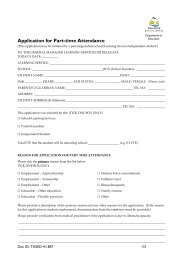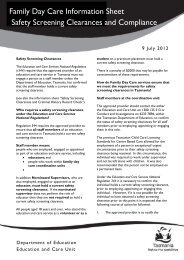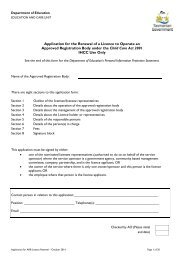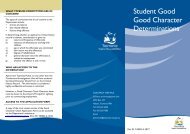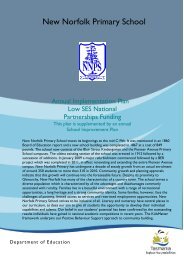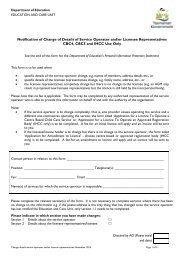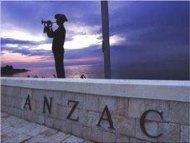PLANNING OFF CAMPUS ACTIVITIES
Procedures for Planning Off Campus Activities - Department of ...
Procedures for Planning Off Campus Activities - Department of ...
- No tags were found...
Create successful ePaper yourself
Turn your PDF publications into a flip-book with our unique Google optimized e-Paper software.
all participants must have canoe clothing and a level 50/50S Lifejacket or equivalent.<br />
a head count check of students should be made at the beginning and end of the excursion,<br />
and at regular intervals during the excursion.<br />
Approval<br />
No specific requirements beyond the Planning Requirements For All Off Campus Activities described<br />
at the beginning of these procedures, and those determined by the school’s or college’s risk<br />
management plan for the off campus activity.<br />
Consent<br />
A signed Consent form for Aquatic (water-based) Activity is mandatory and if there is no signed<br />
consent form obtained the student must not undertake the activity.<br />
Supervision<br />
No specific requirements beyond the Planning Requirements For All Off Campus Activities described<br />
at the beginning of these procedures, and those determined by the school’s or college’s risk<br />
management plan for the off campus activity.<br />
Names and a head count of all participants must be checked and recorded at the beginning and at<br />
the end of the excursion. Regular head counts must also be carried out during the excursion.<br />
Qualifications/Experience<br />
The following qualifications are set out in the Australian Canoeing Award Scheme.<br />
Canoe/Kayak Lifeguard<br />
This qualification is a supervisory award for an enclosed area only.<br />
Holders of the Canoe/Kayak Lifeguard award are qualified to manage a paddling activity in canoes or<br />
kayaks (closed or sit-on-top) in controlled situations, performing rescues as required, where the group<br />
does not leave the immediate launch area. Controlled situations include:<br />
<br />
<br />
<br />
<br />
an area where no environmental forces (waves, wind or current) are acting to separate or<br />
move the group significantly<br />
still water (insignificant tide or river flow)<br />
the ability to see all participants at once<br />
one lifeguard per six boats.<br />
Flat Water Guide or Instructor<br />
<br />
<br />
<br />
<br />
<br />
Holders of the Flat Water Guide and Instructor Award are qualified to operate on inland<br />
waters such as open lakes and rivers (but not on white water or at sea) in controlled<br />
conditions for inland kayaking and canoeing which include:<br />
sheltered and calm waters<br />
minimal wind<br />
ease of access to shore<br />
minimal flow of water.<br />
Please refer to the online copy of this document (TASED-4-1765), located on the Tasmanian Department<br />
of Education’s website to ensure this version is the most recent. P a g e | 49





